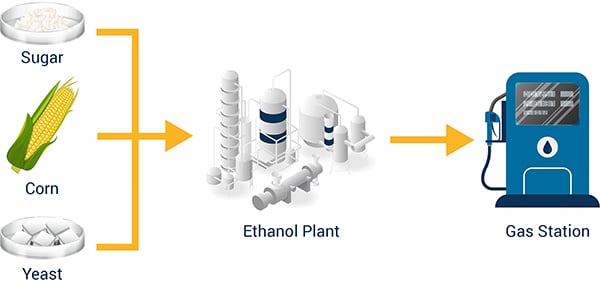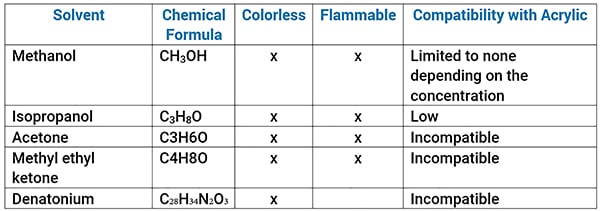Blog Post
Chemical Solvents in Ethanol and the Effect on Sight Glasses
May. 25, 2022

 Photo courtesy of istock/THEPALMER
Photo courtesy of istock/THEPALMER
Ethanol Overview
Ethanol is a chemical compound created through the biological process of fermentation. Ethanol fermentation is an anaerobic process involving sugar, carbon dioxide, and yeast.
Corn is the most common cereal grain used in the production of ethanol in the United States. The starch found in corn is broken down into glucose, a simple sugar. Yeast metabolizes the sugar without oxygen to produce ethanol and carbon dioxide. The process is summarized by this chemical equation: C6H12O6 → 2 C2H5OH + 2 CO2
The fermentation process produces the alcohol found in wine, beer, and spirits. Alternatively, ethanol is used in fuel since it burns cleanly.

Ethanol as a Fuel Source
Alcoholic beverages and pure ethanol are heavily taxed. To reduce the tax burden, ethanol used for fuel is denatured. This is done by adding various chemical solvents to make ethanol toxic and unfit for consumption. This exempts fuel ethanol from liquor taxes, while still allowing the compound to function as a fuel source. The most common denaturing additives are methanol, isopropanol, acetone, methyl ethyl ketone, methyl isobutyl ketone, and denatonium. Table 1 shows the properties of each solvent and its compatibility with acrylic.
 Table 1: Solvent Properties and Compatibility with Acrylic
Table 1: Solvent Properties and Compatibility with Acrylic
Sight Glasses
As mentioned earlier, sight glasses are typically used in petroleum cargo tanks to monitor liquid level and flow. These sight glasses can be made of acrylic or glass.
Acrylic provides a level of safety with good impact resistance compared to glass. If debris from the road is thrown up and strikes the glass tube of the sight glass, it would break causing a significant spill.
Ethanol Solvents' Effect on Acrylic Sight Glasses
The solvents added to denature ethanol are the culprits to blame for reducing the service life of acrylic sight glasses. These additives attack the acrylic, making the sight glass haze, crack, or turn dark yellow. This negatively affects transparency and is a less than ideal situation. However, the durability of acrylic compared to glass makes acrylic sight glasses a more viable option.
Dixon® Sight Glasses
 Dixon's flanged acrylic sight glass
Dixon's flanged acrylic sight glass
At Dixon, we strive to provide quality products built to last. We offer several sight flow indicators compatible with ethanol:
TTMA Flanged Acrylic Sight Flow Indicator - Optically Enhanced Sight Glass
TTMA Flanged Acrylic Sight Flow Indicator
TTMA Flanged Short Sight Flow Indicator
Summary
While it is easy to blame the increased use of ethanol in fuel for the decreased longevity of sight glasses, the real issue is a lack of compatibility between acrylic and the denaturing chemicals added for tax relief.
To learn more, visit our transportation market page or contact a Dixon specialist. We’ve got our sights set on helping you!
 US | en
US | en